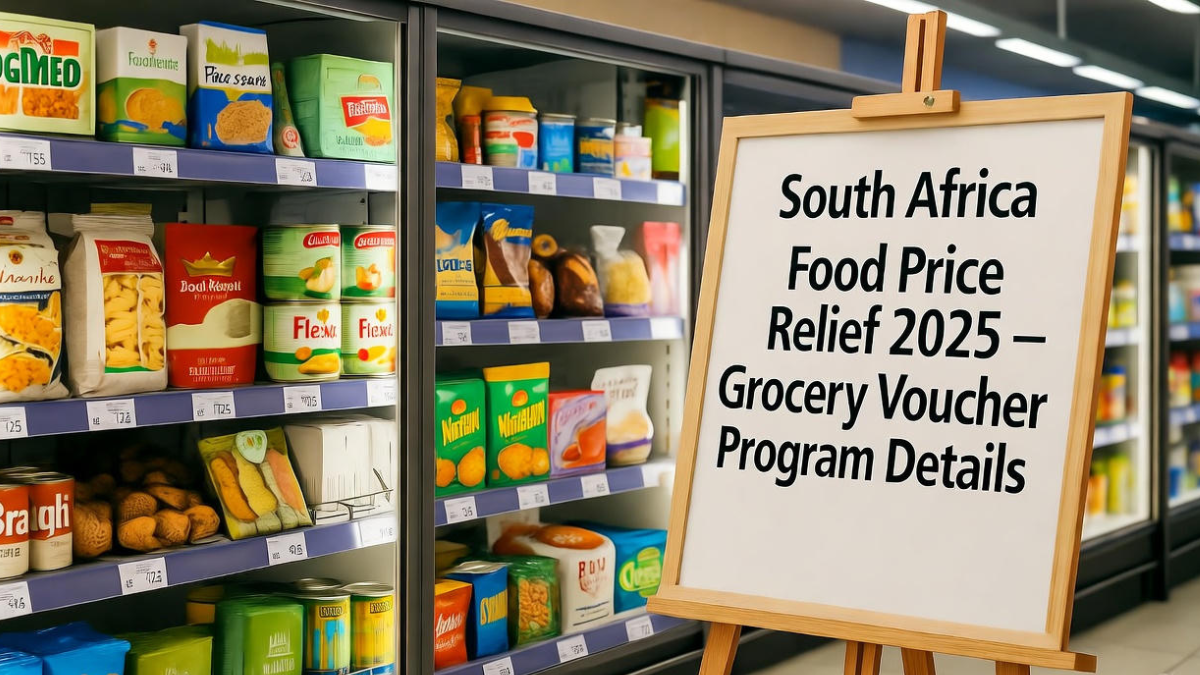The South Africa Food Price Relief 2025 initiative has been introduced as a timely intervention to help low- and middle-income households manage the effects of Inflation and rising food prices. As essential commodities continue to become more expensive, the government has launched this program to ensure that no family goes hungry. This nationwide effort includes the distribution of Grocery Vouchers to millions of South Africans, enabling them to afford basic food supplies and maintain proper nutrition.
This program is part of the government’s broader social welfare and economic stabilization agenda. The South Africa Food Price Relief 2025 plan targets communities most affected by escalating Inflation, aiming to alleviate the burden of high grocery costs and restore purchasing power among citizens.

Objectives and Impact of the South Africa Food Price Relief 2025
The main objective of the South Africa Food Price Relief 2025 is to stabilize household food security while mitigating the effects of Inflation on everyday living. Rising costs of staple items like maize, rice, and cooking oil have significantly affected families across the nation. Through this initiative, the government is addressing both the economic and social impact of these price increases.
Key goals of the program include:
- Providing direct financial assistance through Grocery Vouchers.
- Stabilizing food access for families affected by Inflation.
- Supporting local grocery stores and small retailers participating in the scheme.
- Promoting balanced nutrition through subsidized essential food items.
- Boosting consumer confidence and protecting vulnerable households.
The South Africa Food Price Relief 2025 program also complements existing grants such as the Social Relief of Distress (SRD) and the child support grant, ensuring comprehensive support for struggling families.
Eligibility and Application Process
The South Africa Food Price Relief 2025 program follows a well-defined Eligibility process to ensure fair and transparent distribution. Beneficiaries are selected based on income, household size, and registration in existing government databases. Citizens who already receive social grants are automatically considered for Grocery Vouchers, but additional applications are also open for new participants.
Eligibility criteria include:
- Must be a South African citizen or permanent resident.
- Household income must be below R5,000 per month.
- Priority given to unemployed individuals and single-parent families.
- Must have a valid South African ID and registered mobile number.
- Residents of rural and township areas are encouraged to apply.
Applications can be made online through the government’s official social relief portal or in person at community centers. The South Africa Food Price Relief 2025 program is fully digital, with voucher codes sent directly via SMS once the application is approved.
Grocery Voucher Details and Benefit Structure
The Grocery Vouchers under the South Africa Food Price Relief 2025 scheme are structured to ensure that families receive consistent monthly support to purchase essential food items. The amount varies depending on household size and income level.
Here’s a detailed breakdown of the Grocery Voucher benefits:
| Household Size | Monthly Voucher Amount | Distribution Method | Validity Period |
|---|---|---|---|
| Single Individual | R400 | SMS Code / Digital App | 30 Days |
| Family of 2–4 | R800 | SMS Code / Digital App | 30 Days |
| Family of 5–6 | R1,200 | SMS Code / Digital App | 30 Days |
| Large Family (7+) | R1,500 | SMS Code / Digital App | 45 Days |
These vouchers can be redeemed at participating retailers such as Shoprite, Pick n Pay, Boxer, and Spar. The Grocery Vouchers cover basic food items like maize meal, rice, cooking oil, bread, vegetables, and dairy products.
Addressing Inflation Through Food Subsidies
The South Africa Food Price Relief 2025 directly tackles the challenge of Inflation by offsetting the rising cost of groceries. While global supply chain issues and energy costs have driven food prices higher, this initiative ensures that low-income households are not left vulnerable.
By distributing Grocery Vouchers, the government provides immediate relief without distorting food market prices. Moreover, it encourages responsible spending while supporting local economies. The program also forms part of South Africa’s long-term food security policy, aimed at reducing poverty and improving national nutrition levels.
In the context of persistent Inflation, this initiative stands as one of the most impactful tools to maintain economic balance and social stability.
Conclusion
The South Africa Food Price Relief 2025 is more than a short-term subsidy—it is a comprehensive response to rising Inflation and food insecurity. Through the distribution of Grocery Vouchers, the program strengthens the social safety net and ensures that citizens can continue to afford essential food items amid challenging economic conditions.
By prioritizing inclusivity, efficiency, and transparency, this initiative reinforces the government’s commitment to supporting all South Africans during times of financial stress. The South Africa Food Price Relief 2025 represents hope, resilience, and a collective effort toward national food security.
FAQs
Who qualifies for the South Africa Food Price Relief 2025?
Households earning less than R5,000 per month and registered on social assistance programs are eligible for the South Africa Food Price Relief 2025.
How do I apply for the Grocery Vouchers?
You can apply online through the official government portal or visit a local community center to register for the Grocery Vouchers.
How much is the monthly voucher amount?
The Grocery Vouchers range from R400 to R1,500 depending on household size under the South Africa Food Price Relief 2025 program.
Where can I use my vouchers?
Vouchers can be redeemed at participating national retailers such as Shoprite, Spar, Boxer, and Pick n Pay.
When will the Food Price Relief program start?
The South Africa Food Price Relief 2025 program begins rollout from February 2025 as part of the national response to rising Inflation.
Click here to learn more